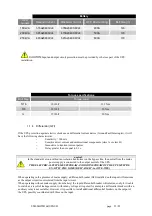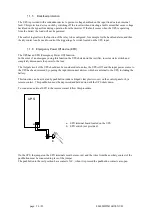
0MLMHTM16RUENUB page 13 / 85
3.3
Cooling of the premises
The recommended operating temperature for the lifetime of the UPS and of the batteries is from 20 to 25°C. The
lifespan of the battery depends on the operating temperature;
with a rise
temperature of 10°C above
20°C , the lifespan of the batteries is halved
.
A heat dissipation system is required to keep the temperature of the
premises where the units are placed within the range of 20-25°C.
The heat dissipation needed for the correct operation of the UPS is by the
air flow generated by the fans located inside the UPS (forced convection)
and by the air surrounding (natural convection).
In order to ensure proper air motion, and therefore the correct operation of
the UPS, countermeasures must be taken during installation to avoid any
obstructions to the free circulation of air. These include the following:
Ensure a distance of at least 24 inches from the ceiling, so as not to
hinder free circulation of air.
Leave a free space of at least 36 inches on the front of the equipment
to ensure both the free circulation of the air and installation and
maintenance operations;
With natural convection the heat is dissipated by temperature
gradients to the outside through the walls; thus a cabinet placed
against a wall or in a recess dissipates less heat than one located in a
free environment.
The following rule must be observed:
Leave at least one of the three side walls free: right, left or back.
The bottom side kick panels must not be mounted for installations where cabinets are lined up.
3.4
Ventilation for battery premises
The premises housing the battery cabinet must have adequate ventilation to prevent the concentration of
hydrogen issued during battery charging and keep it below the danger limit.
The air flow in the premises should preferably be provided by natural ventilation, otherwise by forced
ventilation.
The standard EN 50272-2 for ventilation requires that the minimum opening must satisfy the following equation:
A = 28 x Q = 28 x 0.05 x n x Igas x C10 (1/10³) [cm²]
where:
A =
free opening for air intake and outlet
Q = flow of air to be removed [m³/h]
n = number of battery elements;
C10 = battery capacity over 10 hours [Ah]
Igas = current that produces gas [mA//Ah]
In accordance with the standard: Igas = 1 VRLA type battery (*)
(*) for open vase or nickel batteries, contact the battery manufacturer.
When the equation is applied for 240 elements (40 batteries) sealed lead acid batteries:
A = 336 x C10 / 10³ [cm²]
When using 120Ah batteries, the minimum opening should be approximately:
A = 41 [cm²] or (multiplied by .155) = 6.36 in
2
The ventilation grates for inlet and outlet air must be positioned to ensure the best possible circulation of
air; for example: - on opposite walls,
- minimum distance of 6 ft. when they are on the same wall.




























